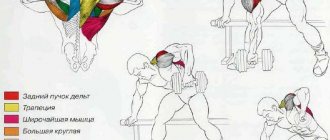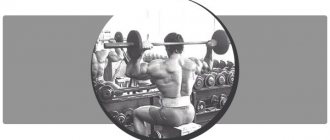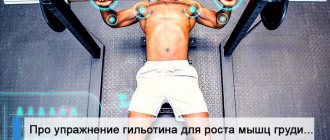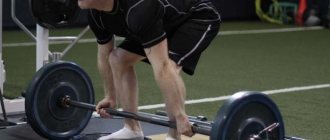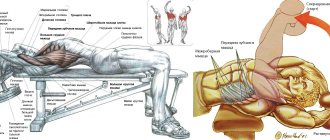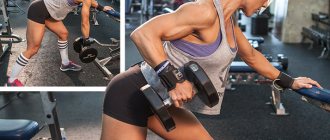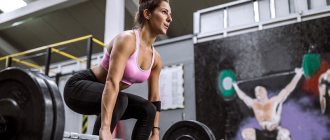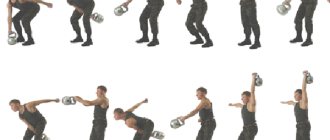Pros and cons of bent over rows
This is a complex exercise that involves several muscle groups. Thus, training using the exercise allows you not only to work out various muscle groups, but also to highly effectively train stabilizers and deep muscles, for example, spinal extensors and abdominal muscles.
The disadvantage of the exercise is considered to be a high risk of injury due to the lack of fixation of the spinal column. Lack of experience aggravates and increases the risk of serious injuries during the training process. This exercise requires adherence to technique and a gradual increase in working weight.
Bent-over barbell rows should not be performed with back and shoulder injuries.
Horizontal block row with forward and reverse grip
An athlete working in deadlifts with a long handle (see photo) has the opportunity to diversify the training process by changing the types of grip.
In most cases, the handle is taken with a wide straight grip. In this option, the emphasis of the load moves to the top of the lats, and the elbows will slightly diverge during movements.
V
Using a reverse grip allows you to get a good stretch in your lower lats. Deadlifts performed in this way involve the biceps to a greater extent, which requires the athlete to seriously concentrate on stretching and contracting the back muscles.
A
The technique of basic movements when performing horizontal rows with a direct and reverse grip has no fundamental differences and is similar to that presented above. To add variety to your training program, it is advisable to use both types of grips, changing them from time to time.
Video: Horizontal block row using different grips
What muscles work when bent over?
- Latissimus dorsi muscles.
- Rhomboid muscles.
- Large round muscles.
- Posterior part of the deltoid muscles.
- Trapezius muscles.
- Back extensors.
- Biceps.
- Shoulder and brachioradialis muscles.
Exercise options
You can pull the weight to different places with a narrow and wide grip, using different handles.
Grip Features
The classic gym offers us 3 options for handles that allow you to pull weights with three grips:
- Lower block row with a narrow grip, palms facing each other. In this case, the middle part of the latissimus muscles works.
- Wide grip row with palms facing in. This grip allows you to pump up the upper part of the latissimus muscles.
- Designed for lat pulldowns, the curved bar allows you to engage the outer lats by holding yourself with a wide grip.
Pull in different directions
Pulldowns of the lower block to different parts of the body force different parts of the back muscles to work. This feature is convenient to use to create an individual contour for your back:
- Pulling the lower block towards the waist allows you to load the middle part of the lats. In general, this movement option is standard and is recommended by most trainers. So, the block row can be one of the exercises in your back day. Another option for the name of the exercise is the pull-down of the lower block to the stomach.
- The groin pulldown will allow you to work the lower part of your lats. This is the most difficult version of the exercise, since the bottom is always weaker than the top (judge for yourself by the volume).
- Seated rows are a common option for beginners. Sometimes this can be a sign that you have taken on a lot of weight and are unable to complete the exercise, bringing it to the belt. If you pull towards your chest, then you know that the upper part of the lats swings more.
Let us remind you that the exercise is done while sitting, not standing. Therefore, most muscles are isolated. However, the legs are slightly tensed to prevent your pelvis from moving with the weight.
Choosing grip width
The traditional grip implies a right angle in the elbow joint when the barbell is pulled to the belt, but the grip can be changed to emphasize different muscles.
- The narrower the hands are on the bar , the more emphasis is placed on the work of the diamond-shaped ones;
- and with a wide grip, the teres major muscles, the back of the deltoid muscles, and also the trapezius muscles are involved in the work.
Straight grip
Bent-over barbell row with an overhand grip
When performing bent-over barbell rows with an overhand grip (overhead grip with palms facing down), the muscles of the upper back (rhomboid muscles, lower and middle parts of the trapezius muscles) work primarily. The pull occurs closer to the chest and not to the belt due to the fact that the elbows look slightly to the sides, and the grip is wider.
Tilt angle
The emphasis on some back muscles can be changed by tilting the torso.
- At a thirty-degree tilt, almost all back muscles are involved;
- and when the tilt changes to forty-five or fifty degrees , the muscles located in the upper back receive the load, namely: the trapezius muscles, the posterior deltoid muscles, as well as the teres minor and major muscles. Of course, the latissimus dorsi and rhomboid muscles are also involved during this exercise, but they work to a lesser extent.
The optimal tilt angle is considered to be close to thirty degrees.
What muscles are involved?
Bent-over barbell rows are a basic exercise for growing the teres major and latissimus muscles, as well as the posterior deltoid muscles.
The latissimus muscles are large muscles of the back that cover the back from below and in the middle. These muscles look especially impressive when an athlete poses; they are also one of the main ones that influence the overall strength of the athlete.
The teres major muscles are located near the upper lateral portions of the latissimus muscles.
The deltoid muscles (posterior bundles) are located behind the shoulder joints.
When performing the exercise, the trapezius and rhomboid back muscles are involved. The trapezius is found in the middle of the back, starting at the base of the skull and extending to the middle of the spine and to the shoulders. The rhomboids are located in the middle of the back next to the trapezius muscles.
You can emphasize the load on different areas of the back by changing the width of the grip, as well as changing the angle of the body.
Effective fat burning thanks to the correct running technique. Read on to learn how to properly run in the evenings. Methods of fighting fat and strengthening the heart.
Here we talk about which muscles swing when doing pull-ups on the horizontal bar.
Protein food - what is it? https://stroy-telo.com/dieta/produkty/vse-chto-neobkhodimo-znat-pro-produkty-soderzhashchie-belok.html
Technique for performing bent-over barbell rows with a straight grip
In order to perform the exercise correctly, the best option for a beginner athlete is to train with light weights.
- The athlete must stand in front of the barbell with his feet shoulder-width apart.
- Your knees should be slightly bent.
- You need to grab the barbell with your palms shoulder-width apart, without bending your elbows, then straighten up. The starting position is as follows: the lower back is slightly bent, the torso is tilted forward. The tilt angle is approximately 30 degrees.
- Legs are bent at the knees. The lower back muscles should be tense.
- The starting point of the barbell amplitude is at the athlete’s knees, the end point of the amplitude is at the waist.
- During the initial movement, inhale, and when pulling the barbell to the belt, exhale, after which, during the reverse return movement to the starting position, inhale again.
- Throughout the entire movement, the elbows should move exclusively back and up, they should not diverge to the sides. The athlete should try to raise his elbows as high as possible.
- Traction is carried out only by the back muscles.
- Remember that the lower back muscles should be tense throughout the entire approach.
- Avoid cheating and jerking. The movement must be performed concentrated and smoothly.
- When performing bent-over barbell rows, your legs and head should remain motionless.
Exercise technique
100% of your progress in sports depends on how thoroughly you follow the correct technique for performing this exercise. The fact is that pulling a barbell towards you while standing in a bent-over position is not a difficult task, but if you really want to build a powerful and strong back, pay special attention to how to do a bent-over barbell row and how to do this exercise with maximum productivity.
Let's go through the technique of performing bent-over barbell rows step by step.
Initial position
Remove the bar from the racks or lift it from the floor. It is recommended to use wrist straps. This will help put less strain on the arm muscles and better concentrate on contracting the lats. Choose your grip based on your goals. An overhand grip at shoulder-width or slightly wider targets the entire lat area, while a reverse grip that is narrower than shoulder-width works the lower lats more isolated. The lifting belt should only be used on really heavy working sets.
Selecting the torso angle
Keeping your back straight, lean back slightly to engage your spinal extensors. The stability of your position depends on the tone of the spinal extensors. Gently lean forward to the desired angle. The greater the angle of inclination, the greater the amplitude of movement, but the more difficult it is to monitor the correct position of the body. The golden mean is about 45 degrees. This way you will work in amplitude sufficient to work your back muscles, and it will be much easier to maintain balance.
Lifting the bar
Start lifting the barbell. It should be carried out slightly in an arc: at the bottom point the bar hangs approximately under the chest, at the top point we try to press it to the lower abdomen. The positive phase of the movement should be accompanied by exhalation. Perform the movement smoothly. Full mental concentration on stretching and contracting the working muscles is required. Try to work by bringing your shoulder blades together, not by bending your elbows. If you can't control the movement or feel like most of the work is being done by your biceps, reduce the weight and work, pausing at the point of peak tension. In the process of lifting the barbell, a little cheating is acceptable, but only on the condition that you keep your back perfectly straight and slightly change the angle of the body.
Lowering the bar
After a short delay at the top, lower the barbell to the starting position. As you lower, remember to take a breath and try to stretch your muscles. An important point: when you lower the barbell down, your thoracic spine should not bend down under its weight - this is fraught with injury, and no athletic belt will help you keep your body motionless. To avoid this, work with more moderate weights and additionally strengthen the spinal extensors by regularly performing hyperextensions and deadlifts.
To increase blood flow to the latissimus dorsi muscles and achieve greater pumping, try working in a static-dynamic style: do not lower the barbell all the way down, thereby maintaining constant tension in the muscles.
All of these technical principles apply to any of the above variations of this exercise. Only the load vectors and which muscle groups receive more stress change.
Bent-over barbell row technique with a narrow reverse grip
This option is considered a more effective, but also more difficult exercise. An interesting fact is that it was invented by Dorian Yates himself! With a reverse grip, the load is placed on the lower latissimus dorsi muscles. Also, the muscles located in the center of the back are not excluded from the work.
When using a reverse grip, the amplitude increases. You can move your hands behind the body a little further. This technique allows you to reduce your back muscles as much as possible. The load on the lower biceps ligament also increases.
- In this case, your palms should be placed shoulder-width apart.
- The torso angle should be approximately 45 degrees.
- A bend in the lower back is necessary.
- The pelvis needs to be moved back a little. We start deadlifting from the level of the shins.
- Be sure to stretch the back muscles at the lowest point of the amplitude.
Pulldown of the lower block to the chest
What muscles work when placing your arms wide and pulling to the chest?
A version of the horizontal block pull-down on the shoulders is performed to the chest with a wide grip. This ensures the development and shifting of the load on the following muscles:
- Posterior deltoids.
- Lat.
- The big and small ones are round.
- All parts of trapezoids.
- Infraspinatus.
The main emphasis shifts to the trapezius and rear deltas.
Technique for performing horizontal block rows to the chest for the shoulders
The technique of pulling the lower block to the chest is almost no different from the classic version, with the exception of the angle and width of the grip.
Peculiarities:
- Take a position with your knees bent on the platforms. Take the long handle where it bends (this is anatomically more convenient, although if such a handle is not available, you can use the usual straight version).
- Start pulling the handle towards your lower chest. Elbows should point to the sides so that your arms are parallel to the floor.
- At the peak point, squeeze your shoulder blades together as much as possible and pause for 0.5-1 second.
Recommendations
The first rule that should be remembered when performing lower block pulls to the chest is that despite the similarity of the movement, you cannot use a lot of weight in this exercise . If in the usual version you can take the maximum possible weight with which you can perform the movement without distorting the technique, then when focusing on the rear deltoids and trapezius, this approach is not only ineffective, but also dangerous.
It is much more effective in this type to work with moderate weight, at a slow pace and in a high-repetition mode (12-15 repetitions). Approaches with a weight of 40-50% of 1RM to failure also work well.
Another difference between the traction of a horizontal block to the chest is the abduction of the body. If, when working on the lats, the body can be swayed up to 10 degrees (to provide additional stretching), then in this option a strong deviation should not be made. The body must be securely fixed, eliminating any swinging and inertia.
Analysis of the lower pulley with a wide grip in video format
Features and technique of bent-over abdominal rows in the Smith machine
The Smith deadlift is performed using a technique similar to the classic exercise. The benefits of working in a Smith machine are obvious. This is an opportunity to fix the load at any point of the amplitude, as well as reduce the load on the stabilizer muscles, since in the simulator the movements are fixed by guides, due to which there are no swings and inaccuracies in movement. This option also allows you to perform the exercise more technically.
An excellent option for training the back muscles for beginner athletes is working in a Smith machine. However, it cannot be said that technically this option for performing traction is simpler.
- To begin with, you should set the bar of the exercise machine at hip level.
- You need to stand in the center and clasp the bar with your palms shoulder-width apart, place your feet hip-width apart.
- Next, you need to remove the bar from the clamps and tilt your body forward at 45 degrees and bend your knees.
- Your arms should be straight at the bottom of the movement.
- As you exhale, you need to stretch the bar to your waist, keeping your elbows close to your body. At the top of the movement, it is important to bring the shoulder blades to the center, contracting the back muscles.
- As you inhale, it is important to smoothly lower the bar to the lowest point, approximately to the middle of the shin. The main thing is not to throw the barbell down and not to swing your body.
- While performing the exercise, the knees and torso remain motionless.
Lower pulley to the waist
What muscles work when pulling a horizontal block while sitting to the stomach?
Main target muscles when performing lat pulldowns with a narrow grip:
- Lat.
- Trapezoidal.
- Biceps.
Additional muscles (partially activated or act as stabilizers to maintain body position):
- Diamond-shaped.
- Lower part of the lats.
- Abdominal muscles.
- Gluteal.
- Leading.
Exercise technique
Mastering the traction of the lower block to the belt while sitting is the primary task for any athlete. Only after this should you increase the weight.
Technique:
- Sit on the bench. Place your feet on the platforms and bend your knees slightly. Grab the handle so that you feel tension in the starting position. The back and neck are completely straight.
- Start pulling the weight towards you at a moderate pace. Bring your hands to your lower abdomen so that your elbows are closer to your body.
- At the peak point, lean back 5-10 degrees to maximize amplitude.
- After a short pause, return to the starting position at a slower pace. Next, roll your shoulders forward to further stretch your lats.
Recommendations
When performing seated horizontal pull-downs, it is extremely important to perform the movement not with the biceps, but with the help of the back and shoulders. In the first part, it is recommended to keep your hands partially relaxed. This will allow you to bring the weight to your stomach using the target muscles. After passing through approximately half the range of motion, it is necessary to engage the arms to maximize the approach to the abdomen. It is also very important at this time to powerfully bring your shoulder blades together.
Horizontal rows while sitting in a machine should not be done at the very beginning of the workout. It is recommended to move on to this exercise after the basic lat movements (pull-ups, etc.) have been completed.
Analysis of the technique of rowing a horizontal block to the belt in video format
Recommendations for performing standing bent-over rows with a barbell for men and women
This exercise is complex and energy-consuming, therefore, depending on the athlete’s level of training, it should be done first or second in the training process. Here is an example of a back workout using this exercise for a beginner athlete:
- Reverse grip pull-ups: 2-4x8-12.
- Wide grip bent over row: 2-4x8-12.
- Horizontal block thrust: 2-4x8-12.
- Hyperextension: 2-4x15-20.
Women can perform this exercise on a Smith machine. Rows can be combined with hyperextensions or reverse pull-ups in a superset. The optimal number of repetitions will be in the range from 20 to 25. You can limit yourself to two or three approaches.
To shift the load to the upper back, pull the barbell towards the chest area and spread your elbows to the sides. This version of the exercise is considered more difficult than the classic one.
Row Handle Options
There are two types of exercise:
- Classic horizontal block pull to the belt - performed with a narrow V-shaped or L-shaped handle .
- The horizontal block pull-down to the chest is an execution option that is aimed at working the upper back (mainly the rear deltas). A rope or wide handle with bends is suitable for this .
The grip depends on the type of handles chosen.
- For a narrow V, this is the neutral position.
- For Wide – straight grip.
- When working with ropes, use a neutral grip with a slightly modified position of the hands.
Adviсe
- Don’t chase a high working weight - first try to understand the exercise, feel all the muscle groups, achieve working out each of them by changing the type and width of the grip, and tilting the body. An excessive increase in the weight of the barbell leads to a sharp increase in the load on the biceps, which are assistants in this exercise and should not work instead of the back muscles.
- Keep your back straight, maintaining a slight arch in your lower back throughout the exercise. Remember, all deadlifts are extremely traumatic exercises for the lower back muscles and the spine as a whole.
- Try not to change the position of your head during the pull , do not turn your head to the sides - look straight ahead just above your eye line - this will keep the position of your back unchanged.
- Check out the video on the Internet demonstrating the correct barbell row technique.
- In general, the exercise is a strength exercise, therefore, execution involves a working weight of 60% of the maximum one-time weight with the expectation of 6-10 repetitions for 3-4 sets.
- Pull the barbell as you exhale, lower it as you inhale . This allows you to stretch the chest and along with it the back muscles at the lowest point, and bring the shoulder blades together at the highest point.
- Monitor your health . If you experience the slightest discomfort or pain in muscles or joints, it is recommended not to continue doing this exercise - replace it with a less traumatic one or consult a doctor.
Bent-over barbell rows are one of the most difficult exercises, but at the same time one of the most effective and comprehensive for the development of back muscles. If you follow these tips, the result will not be long in coming - your overall fitness and results in basic strength exercises will noticeably increase along with your latissimus, rhomboids and trapezius back muscles.
When should you not deadlift?
When you have lower back pain, you can do this exercise by wearing a special orthopedic belt. It is necessary to protect the sacrolumbar spine from unnecessary load. Keep your lats pumping and your lower back safe.
If, while pulling the lower block, your arms hurt in the elbow area, stop doing it. When performing the exercise, the brachialis muscle is connected to the biceps, which can be pulled. It will take a long time to heal, causing discomfort only under significant load.
Benefits of Exercise
Bent-over barbell row allows you to:
- Strengthen the muscular corset of the back by engaging many joints and, as a result, muscle groups;
- When performed correctly, the exercise will improve your posture ;
- Visually enlarge your back by engaging the latissimus, rhomboid and trapezius muscle groups;
- Improve overall fitness and performance growth in basic exercises (an example is the deadlift)
It is important to note that the main load in the exercise should fall on the back muscles, but not on the biceps, which in this case plays the role of an assistant. To comply with this rule, you must do the exercise without violating technique and under the supervision of an experienced trainer in the gym.
